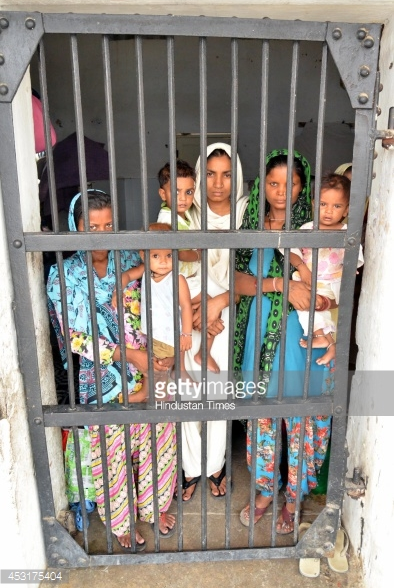When the Protector Becomes the Violator

Krishnendu Nair is a 20-year-old law student intent on improving the justice-delivery system of the country. She believes that even the smallest unit of a society holds the power to profoundly transform a community. She enjoys spending time with children and getting to know the world from their perspective. In her free time, she’s most likely to be found in the company of books, surfing online content or watching documentaries that unveil hard-hitting realities of life.
When the Protector Becomes the Violator
Friedrich Nietzsche in his book Human, All Too Human observed –‘Our crime against criminals lies in the fact that we treat them like rascals.’ These words by the nineteenth-century scholar still hold true in every respect. While the scene of a prison might bring a sense of relief to an ordinary individual, the life of a prisoner is sadistic and barbaric. And in the case of a woman prisoner, it is beyond description, particularly in the Indian setting. Violation of human rights, lack of basic amenities, improper healthcare facilities, alienation to legal aid etc. are just a few everyday fits of abuse to quote. A report by the National Commission for Women (NCW) member Shamina Shafiq on the condition of women prisoners lodged in Central Jail in Raipur, Chhattisgarh, in December 2012 which was inaccessible to public until recently, found that there was no food and water for two days while they were being produced in courts, no doctor to treat sick inmates, no possibility of meeting or speaking to family members.
According to the National Crime Records Bureau (NCRB) of India statistics of 2014, out of the 1387 jails, only 19 are reserved for women. There are around 3000 women who are serving their term in prison and only 12 states have prisons reserved for women. The prison being insufficient is one thing and the lack of staff required to look after them is another. The NCRB data reveals that women staff across jails in the country is less than 25 percent of the total female inmates’ population.
One Hindustan Times report on two Mumbai jails states that life is hell for women inmates. About a 1000 women are cramped up in a space implied for 150. But this is nothing compared to the fact that every month each of the women at the Aadharwadi prison in Kalyan is given only one bar of soap. The same bar is used to wash their clothes, utensils and more importantly, wash themselves. To recount further horrors, these women are provided only two toilets for all of them to share. These blatant violations of basic human rights have resulted in frequent skin ailments and urinary tract infections. There is also a lack of sanitary napkins for women prisoners to be used during their monthly periods.
Likewise, there is a lack of female doctors in prison and minor ailments like headaches and stomach aches are often overlooked. Even more serious issues arise in the case of pregnant women.
On the abuse of human rights, in a report by DNA, Professor Karnam of the TISS’ Nodal Centre of Excellence for Human Rights Education, School of Law Rights and Constitutional Governance described the condition of women inmates as very bad. He mentioned his visit to the Kalyan prison where he saw two HIV-positive women lodged in an isolated prison. According to him, it is strange that even judicial officials do not know about the rules.
If you think that these passive acts on part of various authorities are all, then you are getting the whole picture wrong. Prisoners who have served their terms in prison often allege that they were stripped naked and abused verbally and physically. One inmate from Tamil Nadu prison also alleged that they had to be ready to offer bribes for free legal aid and had to pay escorts failing which they would be beaten up. When a study was conducted by PUCL way back in 1981 regarding the conditions of prison inmates, it was found that poor women and girls were caught on petty charges and left on bail only if they heeded to the sexual desires of the single wardens or policemen. It seems to me that we haven’t really made progress since then and sexual abuse of woman prisoners continues.
The major problem, as with everything else in India, is the poverty. A woman of better socio-economic standing regardless of the basis of her crime generally avails all the privileges in the jail as Rajya Sabha member K. Kanimozhi was sent to Tihar jail on the basis of involvement in high profile 2G spectrum case. The burden of going through all the custodial abuses falls on the poor women who have no other choice but to be trapped between the judiciary and the police. The problem intensifies in the case of tribal women who are taken into custody on charges of being a ‘naxal’. The Hindu reported the statement of 22-year-old Kawasi Hidme released from Jagdalpur prison in Chhattisgarh in 2015. Beaten and raped by the police in custody, she developed severe abdomen pain and vaginal bleeding. But during her time in Jagdalpur prison, when she sought medical care for this, prison authorities denied it initially.
Secondly, the statute which intends to look after the functioning of the prison is Prisons Act, 1894 which is pretty much outdated. It has no specific provisions for women and is without any aims for correction or rehabilitation of prisoners. Further, India is in great need for police reforms. At present, the police are ill trained, ill equipped and in certain cases unaware of the laws themselves. Surveys have revealed that women prisoners stay in fear of prison staff and police at all times.
The problem is also compounded by the indifference of the family members who mostly disown the women once branded as ‘criminal’. As was stated in one official report, ‘it is an extension of the general indifference that Indian society shows to the woman.’ The High Court and Supreme Court have on several occasions tried to formulate orders and rules to uphold human rights of prisoners but any concrete action still remains to be taken.
One might wonder why criminals need or deserve such concern. But in reality half of the prison inmates are undertrials i.e. not proven guilty and even if they are convicted of their crimes, it doesn’t mean that we should be brutal enough to deprive them of basic human rights.
What can be the way ahead? There is a general lack of legal awareness in women prisoners leaving them completely dependent on staff for their necessities. Providing free legal aid services to women detainees becomes vital in such circumstances. Additionally, women are in more need of health care facilities and hygiene especially because of their monthly cycle and consequently there arises a requirement for a general supply of, at any rate, soap and sanitary napkins, notwithstanding lady doctors with 24 hours accessibility. Further, it is observed that women who come out of long-term confinements become socially handicapped. To overcome this hurdle, educational programs, rehabilitation and vocational programs could be incorporated in prisons.
These general solutions may sound basic like making proper rules and guidelines for the protection of human rights, bringing out prison reforms, forming regular committees and panels to keep a check on the working of the prisons and so on but the real challenge lies in the implementation of reforms. Suggestions may be many and innovative too, but proper execution must necessarily follow. The attitude with which the jail authorities treat the prisoners must likewise change.


